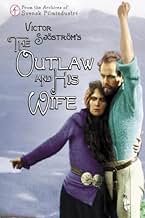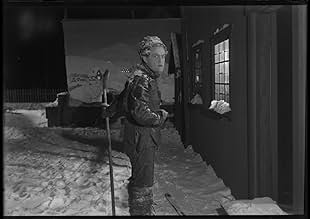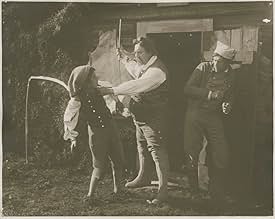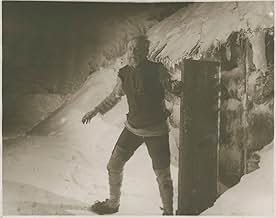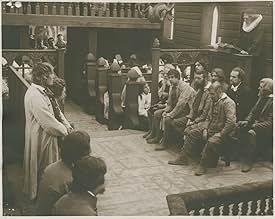IMDb-BEWERTUNG
7,1/10
2237
IHRE BEWERTUNG
Füge eine Handlung in deiner Sprache hinzuEjvind and his family are in need of food. So Ejvind seeks help from the rich priest next door. He refuses to help. Ejvind then steals a sheep from the priest, he is caught. But he escapes f... Alles lesenEjvind and his family are in need of food. So Ejvind seeks help from the rich priest next door. He refuses to help. Ejvind then steals a sheep from the priest, he is caught. But he escapes from prison, and becomes an outlaw.Ejvind and his family are in need of food. So Ejvind seeks help from the rich priest next door. He refuses to help. Ejvind then steals a sheep from the priest, he is caught. But he escapes from prison, and becomes an outlaw.
- Regie
- Drehbuch
- Hauptbesetzung
Walerie Alexandrow-Höök
- Berg-Ejvinds och Hallas dotter Tota
- (as Walerie Alexandrow)
Empfohlene Bewertungen
The Outlaw and His Wife (1918) directed by Victor Sjöström is yet another impressive production in early cinema history.
The story revolves around a stranger who comes to work at a widow's (Halla's) farm. Halla and the stranger fall in love, but when he is revealed as Eyvind, an escaped thief forced into crime by his family's starvation, they flee and become two of the many outlaws of Iceland's mountains.
Victor Sjöström's early films are impressive in their own right. In The Outlaw and his Wife, he almost uses nature as a character, pressuring the humans of the film to the very brink of - and beyond - their moral values. This works effectively in driving a more abstract point of the film; what is one willing to do in order to ensure one's own safety and survival, and yet further abstract; what is good and evil as philosophical constructs?
It is similarly highly recommended for film buffs and those interested in cinema history just like Sjöström's earlier film Terje Vigen (1917), although The Outlaw and his Wife is not as contemporary as Terje Vigen. Lacking a score and being twice as long, it does not feel as focused although it definitely is more epic in its scale and production.
The story revolves around a stranger who comes to work at a widow's (Halla's) farm. Halla and the stranger fall in love, but when he is revealed as Eyvind, an escaped thief forced into crime by his family's starvation, they flee and become two of the many outlaws of Iceland's mountains.
Victor Sjöström's early films are impressive in their own right. In The Outlaw and his Wife, he almost uses nature as a character, pressuring the humans of the film to the very brink of - and beyond - their moral values. This works effectively in driving a more abstract point of the film; what is one willing to do in order to ensure one's own safety and survival, and yet further abstract; what is good and evil as philosophical constructs?
It is similarly highly recommended for film buffs and those interested in cinema history just like Sjöström's earlier film Terje Vigen (1917), although The Outlaw and his Wife is not as contemporary as Terje Vigen. Lacking a score and being twice as long, it does not feel as focused although it definitely is more epic in its scale and production.
On my continued journey through silent film from the early 20th century, this is my favorrite one yet. I found the changing colors much less distracting, and at points even felt like the colors added to the tone of the scene. I particularly enjoyed the costumes in this film, and found the plot much easier to follow than other films of this category. I enjoyed seeing a strong female character, unlike in 'A Man There Was'. There are both laughs and cries throughout this film, and the ending I thought was beautiful. The title cards consisted of more dialogue than I'd seen in previous films, which helped to make the plot more understandable.
It's hard to imagine, but only a few years before this film debuted, most films were only a few minutes long. And, full-length films really were a pretty new thing. So, to see a long, complex and cinematic film like "You and I" shows just how far the industry had grown. Victor Sjöström plays a man who is on the run from the law. Years earlier, he'd been sent to prison for stealing a sheep to feed his family and he'd eventually broken out of a tiny make-shift prison in Iceland. The film picks up when he's on the run in the interior of the country--looking for work and hoping no one recognizes him. In the process, a woman takes him in to work on her farm and eventually the two fall in love....at about the time the law shows up to claim him. The two run off together and live in the inhospitable wilds for the next 17 years (yikes). Exactly what happens is something you'll just need to see for yourself--but it does have some nice surprises.
The film is well worth seeing mostly for the nice acting and cinematography. Interestingly, in addition to starring in the film, Sjöström directed and co-wrote this film--and the look of the film can clearly be attributed to him. I also appreciate how he was able to recreate the look of Iceland nicely by apparently filming in the middle of no where AND in pretty inhospitable weather. A very good film--and it has some nice things to say about crime and punishment.
The film is well worth seeing mostly for the nice acting and cinematography. Interestingly, in addition to starring in the film, Sjöström directed and co-wrote this film--and the look of the film can clearly be attributed to him. I also appreciate how he was able to recreate the look of Iceland nicely by apparently filming in the middle of no where AND in pretty inhospitable weather. A very good film--and it has some nice things to say about crime and punishment.
It is a truism that Victor Sjostrom's films dramatise the conflict between nature and society, but his treatment is less simplistic than might be first apparent. For instance, society in 'The Outlaw and his Wife' is ruled by a brutal, land-grabbing Bailiff who whips servants for losing a sheep; but it is also a place rich in pageantry, costume and rite, where communities can express themselves.
Similarly, nature might be a site of freedom for social outsiders, a sustaining idyll for lovers, and an awe-inspiring backdrop, but it also overflows in the lonely vagrant who comes close to rape, or the cliff and snows that can kill.
Throughout Sjostrom shifts impressively between registers - nature as both real presence and symbolic backdrop; plot as both social depiction and spiritual journey - while retaining familiar action pleasures.
Similarly, nature might be a site of freedom for social outsiders, a sustaining idyll for lovers, and an awe-inspiring backdrop, but it also overflows in the lonely vagrant who comes close to rape, or the cliff and snows that can kill.
Throughout Sjostrom shifts impressively between registers - nature as both real presence and symbolic backdrop; plot as both social depiction and spiritual journey - while retaining familiar action pleasures.
(1918) The Outlaw and His Wife/ Berg-Ejvind och hans hustru
SILENT DRAMA
Co-written, directed and starring Victor Sjöström, he plays an unknown drifter, Kari (Victor Sjöström) looking for work and ends up working at a farm, owned by Halla (Edith Erastoff). And as they begin to fall in love, it is then his past begins to catch up with him that his name is not Kari, but is really Eyvind suspected of escaping from prison. Adapted from the play "Eyvind of the Hills" by Jóhann Sigurjónsson.
A silent Swedish film that is reminiscent of a serious love story that has a complicated situation, that can be used as a basis for movies that come after it.
Co-written, directed and starring Victor Sjöström, he plays an unknown drifter, Kari (Victor Sjöström) looking for work and ends up working at a farm, owned by Halla (Edith Erastoff). And as they begin to fall in love, it is then his past begins to catch up with him that his name is not Kari, but is really Eyvind suspected of escaping from prison. Adapted from the play "Eyvind of the Hills" by Jóhann Sigurjónsson.
A silent Swedish film that is reminiscent of a serious love story that has a complicated situation, that can be used as a basis for movies that come after it.
Wusstest du schon
- WissenswertesBased on the story of Eyvindur of the Mountains (1714-1783), an outlaw in Iceland who fled into the mountains with his wife around 1760 and remained there for twenty years.
- Alternative VersionenTurner Classic Movies has shown on TV a restored version copyrighted in 1968 by Svenska Filminstitutet (The Swedish Film Instute). The restoration credits are in Swedish, but some of the original cast and crew credits are in English. All intertitles are in English and the film runs 73 minutes.
- VerbindungenFeatured in Victor Sjöström - ett porträtt av Gösta Werner (1981)
- SoundtracksKung Kristian II, op. 27
Composed by Jean Sibelius (1898)
Top-Auswahl
Melde dich zum Bewerten an und greife auf die Watchlist für personalisierte Empfehlungen zu.
- How long is Berg-Ejvind och hans hustru?Powered by Alexa
Details
- Erscheinungsdatum
- Herkunftsland
- Offizieller Standort
- Sprache
- Auch bekannt als
- Berg-Eyvind und sein Weib
- Drehorte
- Nuolja, Abisko, Schweden(mountain scenery)
- Produktionsfirma
- Weitere beteiligte Unternehmen bei IMDbPro anzeigen
Box Office
- Budget
- 100.000 SEK (geschätzt)
- Laufzeit1 Stunde 12 Minuten
- Sound-Mix
- Seitenverhältnis
- 1.33 : 1
Zu dieser Seite beitragen
Bearbeitung vorschlagen oder fehlenden Inhalt hinzufügen

